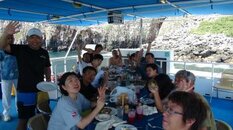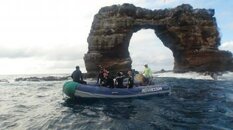- Messages
- 567
- Reaction score
- 16
Galapagos Aggressor II Captain's Log: May 24 - 31, 2012
Galapagos Aggressor II
Log Date: Thursday, May 31, 2012
Entry By: Galapagos Crew
MAY 24th –MAY 31st 2012
First day - Thursday, we arrived to the yacht, after a briefing and light lunch, we prepared for the check out dive in a calm and nice place.
Water temperature 24C.
Visibility 10mt / 30ft.
Current was mild
We saw many juveniles sea lions playing around the divers, that was great, we saw sting ray, and couple of sea turtle.
Second day - Friday, we dove in Sta. Cruz and Santiago, Cousin Rock Islands.
Water condition was very good. Water temperature 24C.
Visibility 15mt / 45ft.
Current was medium
We saw sea turtle, many sea Lions, big school of cow noise golden ray, a group of mobulas very close, small school of eagle ray, white tip reef shark, sting ray. We also saw many sea turtle in a cleaning station posture.
Saturday, Sunday, Monday we arrived to Darwin and Wolf, one of the top ten dive sites on earth, condition was excellent.
Water temperature 26C.
Visibility was about 16mt /48ft.
Current was medium to strong
We had the opportunity to see giant school of hammerhead shark, Galapagos shark, silky, everywhere, during our dive we also had the opportunity to see small group of eagle ray, they were swimming and eating very close to us, for a while, during the safe stop there were many silky everywhere, dolphin under water and also in the surface, some of us had the opportunity to saw Whale shark.
Tuesday after spending time at north we finally arrived to Isabela for our last day diving on Pta. Vicente Roca.
Water temperature 21C.
Visibility 8mt/ 24ft.
Current slow
We had the opportunity to see many sea lions, penguins, flightless cormorant, many sea turtles, marine Iguanas, blue footed boobies in the water fishing, sea horse, small fishes, as red lip but fish, etc.
Wednesday We arrived to Santa Cruz Islands in order to make our land tour day, we visited amazing geological formation, as big collapse, lava tune, also we visit the giant tortoise in the wild, and once in town we visit the famous Charles Darwin Research station, we learned about the program of reproduction center of giant tortoises, land iguanas, and we saw the famous tortoise Lonesome George.
Thursday, San Cristobal airport.
Thanks for a great week: Peng, Xuefeng, Tan, Chao, Wei, Chang, Wei, Bingbing, Dong, wei, Shengkui, Ping, Shuyan, New Keong, from China.
Safe dives!
Gustavo Barba
Galapagos Aggressor Instructors



Galapagos Aggressor II
Log Date: Thursday, May 31, 2012
Entry By: Galapagos Crew
MAY 24th –MAY 31st 2012
First day - Thursday, we arrived to the yacht, after a briefing and light lunch, we prepared for the check out dive in a calm and nice place.
Water temperature 24C.
Visibility 10mt / 30ft.
Current was mild
We saw many juveniles sea lions playing around the divers, that was great, we saw sting ray, and couple of sea turtle.
Second day - Friday, we dove in Sta. Cruz and Santiago, Cousin Rock Islands.
Water condition was very good. Water temperature 24C.
Visibility 15mt / 45ft.
Current was medium
We saw sea turtle, many sea Lions, big school of cow noise golden ray, a group of mobulas very close, small school of eagle ray, white tip reef shark, sting ray. We also saw many sea turtle in a cleaning station posture.
Saturday, Sunday, Monday we arrived to Darwin and Wolf, one of the top ten dive sites on earth, condition was excellent.
Water temperature 26C.
Visibility was about 16mt /48ft.
Current was medium to strong
We had the opportunity to see giant school of hammerhead shark, Galapagos shark, silky, everywhere, during our dive we also had the opportunity to see small group of eagle ray, they were swimming and eating very close to us, for a while, during the safe stop there were many silky everywhere, dolphin under water and also in the surface, some of us had the opportunity to saw Whale shark.
Tuesday after spending time at north we finally arrived to Isabela for our last day diving on Pta. Vicente Roca.
Water temperature 21C.
Visibility 8mt/ 24ft.
Current slow
We had the opportunity to see many sea lions, penguins, flightless cormorant, many sea turtles, marine Iguanas, blue footed boobies in the water fishing, sea horse, small fishes, as red lip but fish, etc.
Wednesday We arrived to Santa Cruz Islands in order to make our land tour day, we visited amazing geological formation, as big collapse, lava tune, also we visit the giant tortoise in the wild, and once in town we visit the famous Charles Darwin Research station, we learned about the program of reproduction center of giant tortoises, land iguanas, and we saw the famous tortoise Lonesome George.
Thursday, San Cristobal airport.
Thanks for a great week: Peng, Xuefeng, Tan, Chao, Wei, Chang, Wei, Bingbing, Dong, wei, Shengkui, Ping, Shuyan, New Keong, from China.
Safe dives!
Gustavo Barba
Galapagos Aggressor Instructors
























































